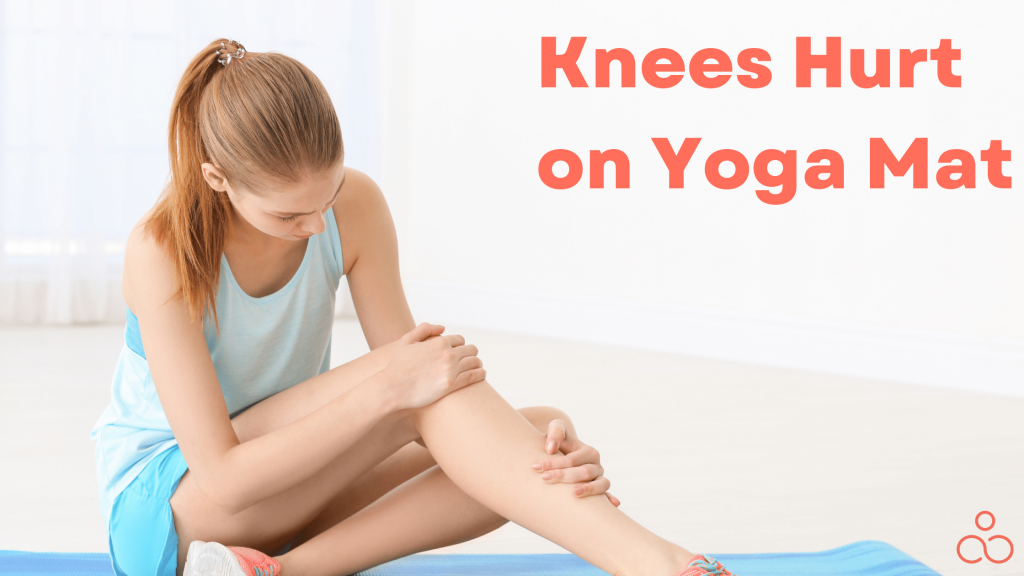Have you ever been on a Yoga mat with aching knees? If you’ve ever experienced knees hurt on a Yoga mat, you’re not alone. But if your knees are hurting constantly during Yoga, it’s essential to find out why. Could it be the mat itself or something else entirely? Read on to discover the causes of knee pain on the Yoga mat and how to fix it.
Anatomy of the knee
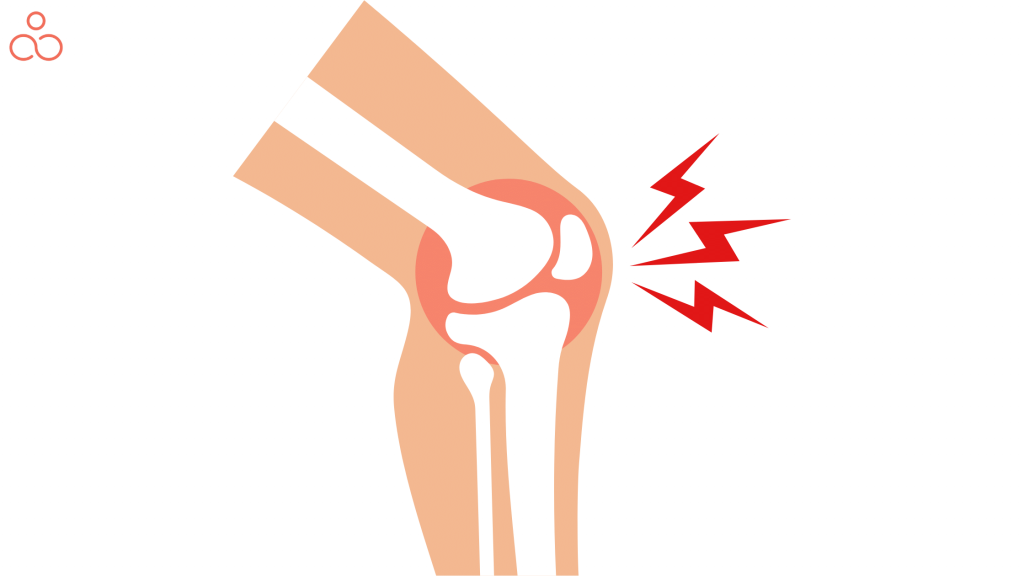
The knee is a complex joint that is made up of four bones, the femur, tibia, fibula, and patella. The femur is the largest bone in the body and is responsible for supporting the majority of the body’s weight. The tibia and fibula are the two smaller bones that are located on the outer aspect of the knee. The patella, or kneecap, is the bone that is located in the front of the knee and helps to protect the joint. The knee joint is made up of a series of ligaments, tendons, and muscles that help to stabilise the joint and allow it to move smoothly.
Knee pain in Yoga
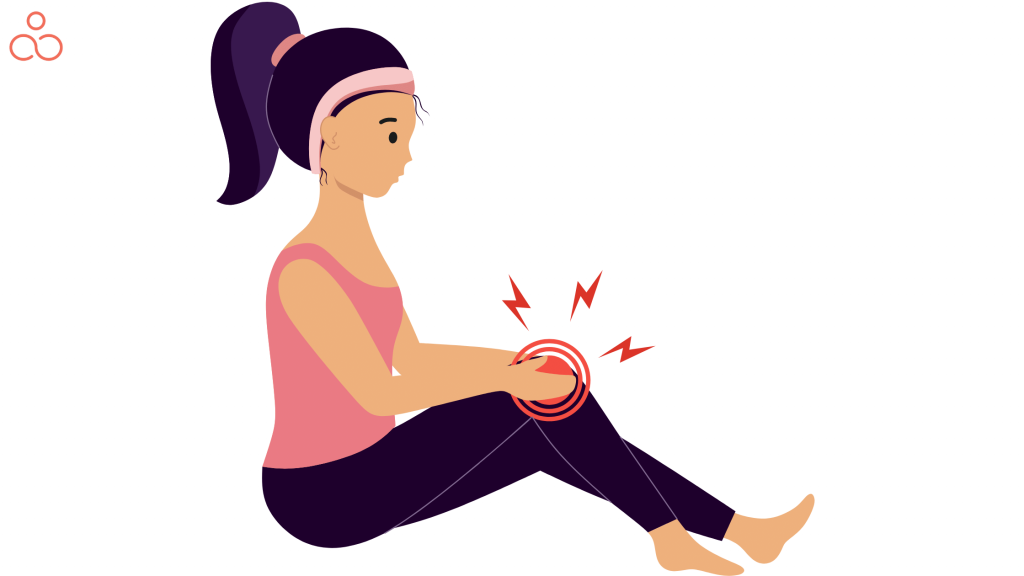
Yoga is an excellent way to improve overall health and well-being. A clinical study conducted on a group of people with rheumatoid arthritis and osteoarthritis resulted in positive reduction of knee pain and promotion of general physical wellbeing. However, it can also lead to pain in the knees if done incorrectly. It is essential to properly warm up the body before starting a Yoga routine, as this can help to avoid potential issues. Additionally, practising proper alignment and using the right props and supports when needed is essential. Finally, be sure to listen to your body and never do anything that causes pain or discomfort. Incorporating these tips will help reduce knee pain risk and make your Yoga practice more enjoyable.
How are Yoga mats for knee pain helpful?
Yoga mats provide cushioning for the knees, which helps absorb the shock of impact when performing specific exercises. This helps reduce the stress on the knees and helps alleviate knee pain. Additionally, Yoga mats provide additional traction, which can help users keep their balance during exercise. This can be especially helpful for those with knee pain who have difficulty with balance. Also, Yoga mats can provide a comfortable surface to sit on, which can be especially beneficial for those with knee pain who may have difficulty sitting on hard surfaces.
Why do the knees hurt on a Yoga mat?
Knee pain is a common issue among people who practise Yoga on mats. This is because the mat you use while providing cushioning and support can be too hard or soft, leading to pressure on the knees and resulting in discomfort or even pain. Additionally, certain Yoga poses can place extra pressure on the knees if the body is not correctly aligned. So to get rid of pain, it is essential to use the correct type of mat for your body and practise good alignment. Furthermore, taking regular breaks and using props such as Yoga blocks or Yoga bolsters to support the body can help ease the pressure on the knees and reduce pain.
What to do if your knee hurts on the Yoga mat?
Got aching joints during Yoga? Don’t worry! Here are some tips to make your Yoga session more pleasant:
Give yourself a cushion
Fold your mat in half or even a few times for added padding. You can fold it from the top or side, so you don’t have to adjust your mat much.
Grab a blanket or towel
If you don’t have an extra Yoga blanket, use a folded-up piece of clothing or a towel. If you often get cold during Yoga, get some extra layers – you can use them for extra cushion too!
Get a double layer
If your studio has extra mats, lay your mat on top of the studio’s mat for extra resilience. Just make sure another yogi doesn’t need it!
Invest in a new mat
If none of these is providing the help you need, maybe it’s time to get yourself a new mat with extra padding. It’s the most important thing for your practice, after all!
Yoga mat for knee support to avoid knee pain
A Yoga mat that is good for knee pain and support should have the following features:
- Thickness: A thick mat is better for supporting the knees and provides more cushioning.
- Material: Look for a mat made from dense foam or a material that has good grip to prevent slipping and accordingly support the knee joints.
- Texture: A textured surface can provide better traction and reduce the risk of slipping.
- Length and Width: Ensure the mat is long enough to accommodate your full body and wide enough to provide extra support to the knees.
- Comfort: Look for a Yoga mat with a comfortable surface that won’t rub against your knees causing pain.
Types of Yoga mats for knee pain
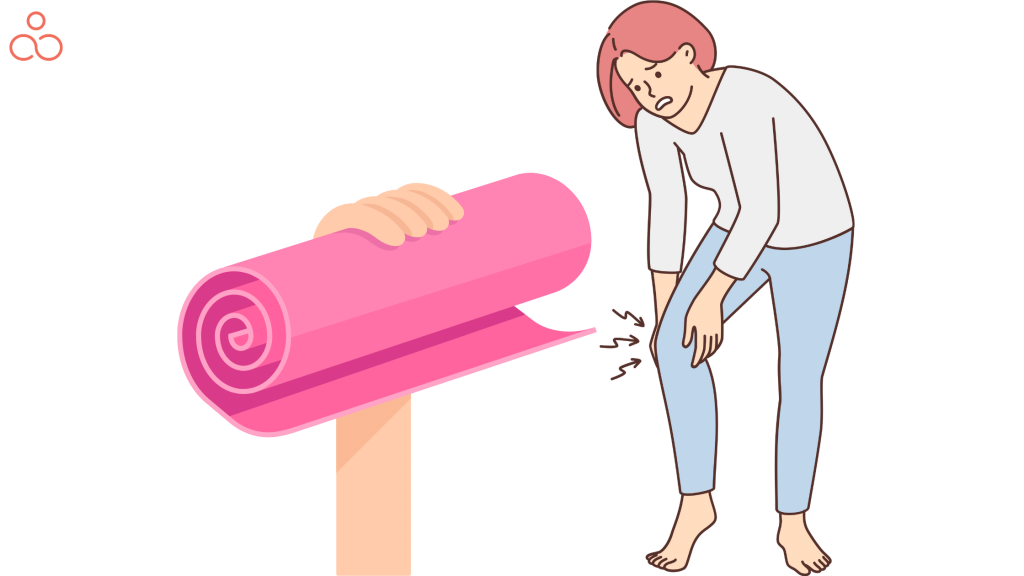
Knee pain can be uncomfortable, but luckily two types of Yoga mats can help alleviate it.
Thick mats
They are great for cushioning and providing stability.
Thick mats to avoid knee pain
Thick mats are a great way to reduce pressure on your knees and prevent knee pain. They provide extra cushioning and support, making it easier for your joints to move without putting too much strain on them. Additionally, these thick mats are designed to fit your body’s shape, so you can find the perfect mat for your needs. Investing in a thick mat for your knees can help you stay comfortable and pain-free.
How thick should a Yoga mat be?
Yoga mats come in various thicknesses, ranging from 1/8 to 1/4 of an inch. A thicker mat is usually the best choice for people who experience knee or joint pain since it provides more support and cushioning. If you find that a thicker mat makes your joints feel better, it’s a good idea to switch to a thicker mat to ease your pain.
Padded mats
They are great for extra padding for extra support.
Padded mats to avoid knee pain
Using padded mats when exercising is essential to avoid strain and discomfort in your knees. The padding in the mats will help to absorb impact and provide cushioning to the knee joint while you exercise. Padded mats can be found at most sporting goods stores and online. It is vital to ensure the mats are made with a durable and high-quality material that will hold up to regular use. Additionally, the mats should be thick enough to provide sufficient cushioning and support for your knees.
How much extra padding should a Yoga mat be?
Your Yoga mat should have at least 3/4 of an inch extra padding to avoid knee pain. If you are looking for extra cushioning, you can opt for an inch or more padding for maximum comfort.
7 reasons why extra padded and thick mats are good to avoid knee pain
Knee pain is a common problem that can be exacerbated by hard surfaces. Extra padded and thick mats provide an added layer of cushioning and support to the knees and can help alleviate pain and prevent further injury. Here are 7 reasons why extra padded and thick mats are suitable for your knees:
Added Comfort
Extra padded and thick mats provide a comfortable surface for your knees, reducing pressure on the knees and joints.
Reduced Pain
The added cushioning can help reduce the pain associated with knee problems, allowing you to move more freely.
Protection
The extra padding can help protect the knees from further injuries, such as bruising.
Improved Mobility
The cushioning can also help improve your mobility, allowing you to move more freely without pain.
Support
The extra padding can provide extra support to the knees, helping to keep them in the correct position.
Improved Posture
The cushioning can also help improve your posture, allowing you to stand or sit more comfortably.
Overall benefit
Extra padded and thick mats can be a great way to help reduce knee pain and prevent further injury. They provide an added layer of cushioning and support that supports overall benefits.
What props to use to give your Yoga mat some extra padding or thickness?
For people with sensitive knees, Yoga can be a great way to help increase flexibility and reduce pain. If you suffer from knee pain, using the right props and modifications is essential to get the most out of your practice. Here are four Yoga props to help support your knees:
Knee Pads
Knee pads help to cushion your sensitive knees, allowing you to perform Yoga poses without feeling pain.
Bolster
A bolster can support your hips and lower back when you are in a reclining position. This helps to reduce pressure on your knees.
Blocks
Blocks can support your body weight when performing standing poses. This helps reduce the poses’ intensity while still allowing you to benefit from them.
Yoga Strap
A Yoga strap can help deepen a pose without placing too much pressure on your hips and knees.
10 things to look for in a Yoga mat to avoid knee pain
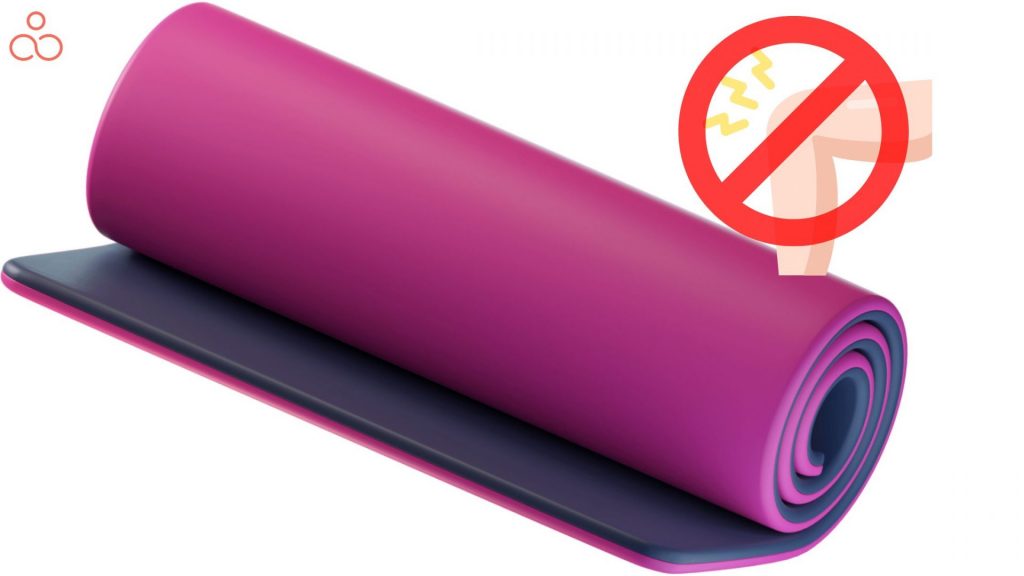
When shopping for a Yoga mat, there are several essential features to look for if you want to avoid knee pain.
- Look for a mat at least 1/4 inch thick to provide cushioning for your knees.
- Make sure the mat is non-slip so your feet and hands stay in place during poses.
- Look for a mat that is made of a material that absorbs sweat, so you stay comfortable.
- Consider the size of the mat; make sure it is large enough to support your poses comfortably.
- Make sure the mat is easy to clean and maintain.
- Make sure the mat is lightweight and durable.
- Look for a mat with an adequate grip.
- If you are a beginner, look for a mat with extra cushioning to protect your joints.
- If you are more experienced, look for a mat with more grip for better balance and stability.
- Consider the cost; find a good value mat for the price.
With these ten features in mind, you can find a Yoga mat to help you avoid knee pain and stay comfortable while practising.
Yoga poses for knee pain on the Yoga mat
Downward Facing Dog
Downward facing dog is a great Yoga pose to help alleviate knee pain. It helps to stretch and strengthen the legs, hips, and lower back which can all contribute to knee pain. This pose also improves circulation and helps to reduce stiffness in the knees.

Chair Pose
The chair pose is a great way to alleviate knee pain by strengthening the muscles in the legs and improving balance. It works by engaging the quadriceps, hamstrings, and gluteus muscles in particular, helping to provide stability to the knee joint.

Warrior I
Warrior I is a popular Yoga pose that can be helpful in reducing knee pain. It helps in stretching and strengthening the muscles around the knees, thus providing better support to the joint.

Warrior II
One of the benefits of Warrior II pose is that it can help alleviate knee pain. This pose strengthens the muscles around the knee joint, improves circulation, and can even help increase flexibility, all of which can reduce discomfort in the knee. Additionally, Warrior II is a weight-bearing pose, which can help improve bone density and prevent conditions like osteoporosis.
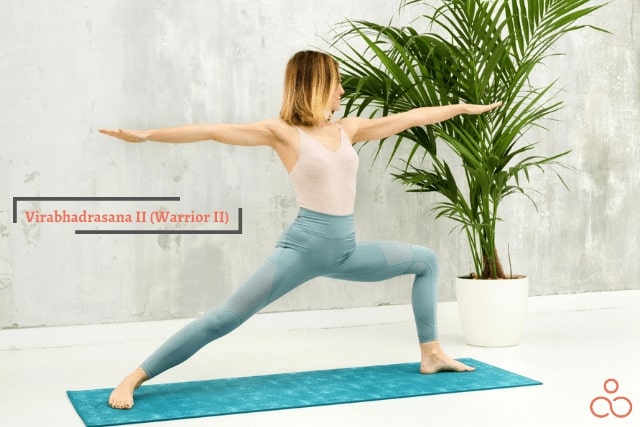
Half Moon Pose
The half moon pose can help to alleviate knee pain by strengthening the muscles in the legs and knees, improving flexibility and balance, and increasing circulation to the affected area. Additionally, the pose can help to reduce stress and tension in the body, which can contribute to knee pain.

Triangle Pose
The Triangle pose can help alleviate knee pain by stretching and strengthening the leg muscles around the knee joint. It can also improve flexibility and circulation in the area. However, it is important to perform the pose correctly and consult with a doctor or physical therapist before starting any new exercise routine, especially if you have a history of knee injuries or pain.
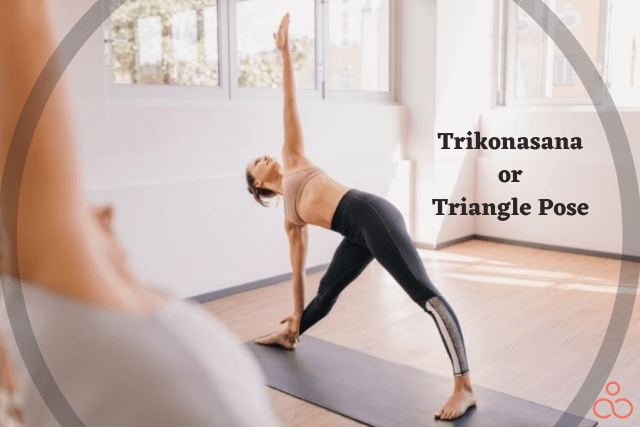
Pigeon Pose
Pigeon pose is a beneficial Yoga pose for those with knee pain as it can help to open up the hip flexors and increase flexibility in the hips and lower back. This can alleviate pressure on the knee joint and reduce pain. It can also help to strengthen the muscles surrounding the knee, providing better support and stability.
Crescent Lunge
The crescent pose can improve balance and stability, which can help prevent future knee injuries. Additionally, the pose can increase circulation throughout the body, which can further aid in reducing inflammation and pain in the knees.
Tree Pose
The tree pose in Yoga can help alleviate knee pain by strengthening the muscles around the knee joint, improving flexibility, and increasing the range of motion. It can also help improve balance and stability, reducing the risk of falls and further injury to the knee.
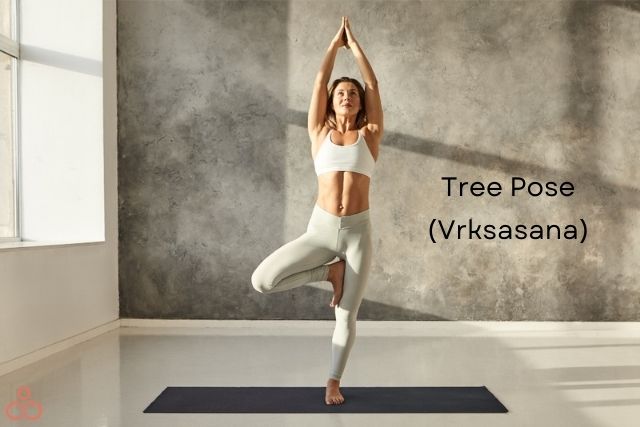
Bridge Pose
Bridge pose can help stretch and strengthen the muscles that support the knees, reduce stiffness and improve mobility in the knee joint, and promote blood flow to the affected area to aid in healing. When done regularly and correctly, bridge pose can be an effective measure in managing knee pain.
Modifications that you can make
- For individuals experiencing knee pain, kneeling can often be a painful activity. However, this discomfort can be alleviated by elevating the shins, which will reduce pressure on the kneecaps.
- For optimal alignment of the knees during standing postures, it is advised to place a block beneath the knees. This adjustment helps to align the knees with the middle toes, leading to a safer and more efficient practice.
- While performing seated hip-openers, ensure that the knees are supported with rolled blankets or blocks to prevent depression and rotational force during forward bending. Raise the pelvis to aid hip joint rotation.
- If your knees hurt, don’t do a deep warrior position. Move your feet closer together. Make sure your knee is in the right spot by putting your front knee over or behind your ankle and pointing your kneecap towards your second toe. To keep your arch engaged, pick up and put down your big toe.
- To prevent knee pain during Yoga, it is recommended to avoid bending the knees completely. When performing seated postures, it is essential to ensure proper support of the pelvis to avoid the knees from bending fully.
Tips
To enhance the comfort of your Yoga practice, there are various techniques to increase your mat’s cushioning. Here are some useful ideas to consider:
- Folds can be a great start. Place your mat in position, and fold it once or twice at the top or side of the mat. This will help reduce the need to adjust yourself constantly during the session. Another excellent option is to use a folded Yoga blanket or towel under areas that cause discomfort. If you don’t have a Yoga blanket or towel, don’t worry. Just use a folded piece of clothing like socks, in the painful areas. Wearing layers of clothing is also a smart and creative way to adjust your body temperature and provide extra padding where necessary.
- Hip joint mobility plays an important role in maintaining proper alignment and reducing stress on the knees during Yoga practice. Increasing hip mobility can help distribute the weight evenly across the body, reducing the load on the knees. Some Yoga poses that may help improve hip joint mobility include pigeon pose, lizard pose, and butterfly pose. Additionally, incorporating hip-opening exercises into your regular workout routine can help improve overall hip flexibility and mobility.
- The knee moves like a hinge and can also rotate. If we forcefully rotate it, it can cause harm. Be aware of any discomfort or pain in the knee. Sometimes our body temperature makes us believe that we can move beyond our limits. To avoid this, move or bend the foot of the leg which is rotated externally. This stabilises the joint and moves the leg in a single direction. You can use this method to protect your knee while performing postures where your leg is externally rotated and your knee is almost closed.
- The positioning of your feet can greatly impact your knees. If your kneecap is able to slide without any issues, thanks to equally strong ligaments on both sides of your knees, you’ll prevent the cartilage beneath the patella from wearing down. To maintain a healthy arch and optimal weight distribution, it’s timely to practise balancing postures with a straight, standing leg for training the feet’s muscles.
- The knee and hip have a close link and work together. If we elevate our hips higher than our knees, we can move with ease, which may avoid knee discomfort during Yoga and decrease the risk of injury. Alternatively, raising our knees higher than our hips also contributes to avoiding knee problems.
FAQs
What to do if your mat isn’t so padded or thick?
If your mat needs to be more padded or thick, you can do a few things to make it more comfortable. You can add extra paddings, such as a thin foam layer or a Yoga bolster, or get a thicker mat. If you don’t want to replace your mat, you can get a Yoga towel that adds extra padding and absorbs sweat. You can also use a blanket or a cushion to add more padding and comfort. Finally, you can use a Yoga strap or belt to loop around your mat and hold it in place to prevent slipping and add extra cushion.
How thick should an extra-thick mat be?
When looking for a mat for extra cushioning for knee pain, it is crucial to look for one that is at least one inch thick. Anything less than that may not offer enough support for a person’s knees and could increase the risk of further pain and discomfort.
Are the thick mat and padded mat the same?
Mats that are extra padded and thick have a lot of similarities, but there are some critical differences between them. Extra padded mats provide a softer surface, which can benefit those looking for more cushioning and support. Thick mats are usually firmer and provide a more stable surface, which can benefit those needing a more secure foundation. Ultimately, it comes down to personal preference and the activity you’ll use the mat for when deciding which is suitable for you.
If you practise Yoga on a regular carpet, will you get unwanted knee pain?
There may be better ideas than practising Yoga on a regular carpet, as the hard surface may cause undue strain on your knees. It’s best to invest in a Yoga mat, as it will provide the necessary cushioning and support for your knees during your practice. Additionally, you should pay attention to your form and always practise Yoga on a flat surface.
What can I use instead of a Yoga mat to avoid knee pain?
If you don’t have a Yoga mat, you can still practise Yoga and avoid knee pain using a thick blanket, towel, or carpet padding. Make sure to place the material on a firm and flat surface. You can also use a foam roller or a cushion to help support your weight and alleviate pressure on your knees. Additionally, try to practise Yoga poses that are gentle on the knees. Be mindful of your alignment and body placement during each pose.
How to find a Yoga mat of perfect thickness to avoid knee pain?
Finding the right Yoga mat for you can be a challenge. The mat’s thickness is essential, as it affects how much cushion and support your knees get during practice. For those with knee pain, thicker mats are usually the better option. Look for mats that are at least 1/4 inch thick or greater. You can also find mats that are specifically designed for those with knee pain, which may be thicker than standard mats. Try out mats in person before buying them to make sure it’s the right ones for you.
How can you skillfully use a Yoga mat to avoid knee pain?
Choose a mat that has enough cushion and thickness. A thicker mat will better absorb shock and pressure, helping protect your knees. Place the mat in an area that has enough space. This will reduce the risk of your knees hitting the floor when you move into different poses. Start with poses that don’t require the knees to bend too far. This will give your knees time to adjust and will prevent any undue stress on them. Make sure your knees are correctly aligned with your hips and spine when performing poses. This will help to keep your knees in the proper position and reduce the strain on them. Take breaks when needed. If your knees start to feel uncomfortable, take a break and return to a comfortable position for a few breaths before continuing. Following these tips, you can use your Yoga mat to protect your knees from pain and make the most out of your practice.
Conclusion
Yoga mats are not a cure-all for knee pain and, in some cases, can even contribute to the problem. However, suppose the correct type of mat is used correctly and with proper alignment. In that case, it can provide cushioning, support, and stability, which can help alleviate some of the pain associated with knee issues. In conclusion, Yoga mats can be beneficial for those with knee pain. Still, we would like to recommend that it should be used with some extra caution.

